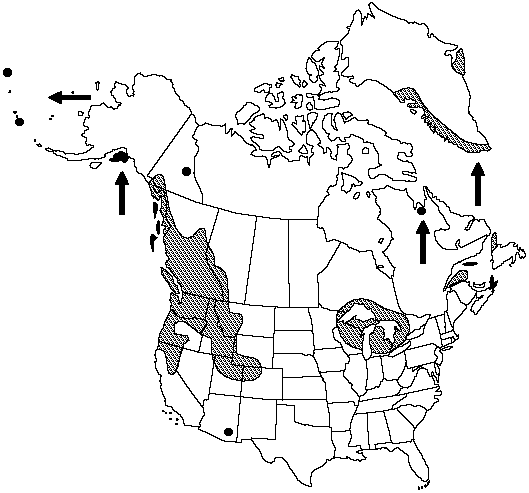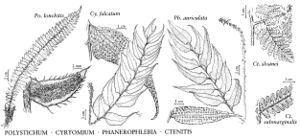Difference between revisions of "Polystichum lonchitis"
Tent. Fl. Germ. 3(1): 71. 1799.
FNA>Volume Importer |
FNA>Volume Importer |
||
| Line 20: | Line 20: | ||
}}<!-- | }}<!-- | ||
| − | --><span class="statement" id="st- | + | --><span class="statement" id="st-undefined" data-properties=""><b>Stems </b>erect to occasionally ascending. <b>Leaves</b> erect, not arching except at tip, 1–6 dm; bulblets absent. <b>Petiole</b> 1/10–1/6 of blade, densely scaly; scales light brown, gradually diminishing in size distally. <b>Blade</b> linear, often widest above middle, 1-pinnate, base narrowed. <b>Pinnae</b> oblong to lanceolate to falcate, proximal pinnae ± deltate, rarely overlapping, in 1 plane, 0.5–3 cm, base truncate to oblique, acroscopic auricle well developed; margins serrulate-spiny with teeth spreading; apex acute, subapical tooth hardly smaller than apical tooth; microscales dense, on abaxial surface only. <b>Indusia</b> entire or minutely dentate-erose. <b>Spores</b> dark brown. <b>2n</b> = 82.</span><!-- |
-->{{Treatment/Body | -->{{Treatment/Body | ||
| Line 50: | Line 50: | ||
|publication year=1799 | |publication year=1799 | ||
|special status= | |special status= | ||
| − | |source xml=https://jpend@bitbucket.org/aafc-mbb/fna- | + | |source xml=https://jpend@bitbucket.org/aafc-mbb/fna-data-curation.git/src/9216fc802291cd3df363fd52122300479582ede7/coarse_grained_fna_xml/V2/V2_382.xml |
|genus=Polystichum | |genus=Polystichum | ||
|species=Polystichum lonchitis | |species=Polystichum lonchitis | ||
| − | |||
| − | |||
| − | |||
| − | |||
| − | |||
| − | |||
| − | |||
| − | |||
| − | |||
| − | |||
| − | |||
| − | |||
| − | |||
| − | |||
| − | |||
| − | |||
| − | |||
| − | |||
| − | |||
| − | |||
| − | |||
| − | |||
| − | |||
| − | |||
| − | |||
| − | |||
}}<!-- | }}<!-- | ||
-->[[Category:Treatment]][[Category:Polystichum]] | -->[[Category:Treatment]][[Category:Polystichum]] | ||
Revision as of 14:18, 27 July 2019
Stems erect to occasionally ascending. Leaves erect, not arching except at tip, 1–6 dm; bulblets absent. Petiole 1/10–1/6 of blade, densely scaly; scales light brown, gradually diminishing in size distally. Blade linear, often widest above middle, 1-pinnate, base narrowed. Pinnae oblong to lanceolate to falcate, proximal pinnae ± deltate, rarely overlapping, in 1 plane, 0.5–3 cm, base truncate to oblique, acroscopic auricle well developed; margins serrulate-spiny with teeth spreading; apex acute, subapical tooth hardly smaller than apical tooth; microscales dense, on abaxial surface only. Indusia entire or minutely dentate-erose. Spores dark brown. 2n = 82.
Habitat: In rock crevices or at base of boulders, mostly in boreal and subalpine coniferous forests or alpine regions
Elevation: 0–3200 m
Distribution

Greenland, Alta., B.C., Nfld., N.S., Ont., Que., Yukon, Alaska, Ariz., Calif., Colo., Idaho, Mich., Minn., Mont., Nev., Oreg., Utah, Wash., Wis., Wyo.
Discussion
The hybrid between Polystichum lonchitis and P. acrostichoides (= P. × hagenahii Cody) is discussed under P. acrostichoides. The hybrid with P. braunii (= P. × meyeri Sleep & Reichstein) is discussed under P. braunii. In the Georgian Bay area of Ontario, P. lonchitis hybridizes with Dryopteris goldiana to produce the peculiar × Dryostichum singulare W. H. Wagner (W. H. Wagner Jr., F. S. Wagner et al. 1992).
The spiny spores of P. lonchitis are distinctive and distinguish this from dwarfed forms of other 1-pinnate species.
Selected References
None.
